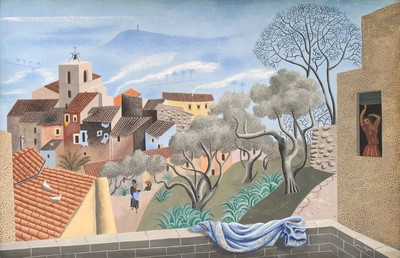Jean Hugo
the 28 June 2019
magicien
Jean Hugo (1894-1984), great grandson to Victor Hugo, is very much present in the collections of the villa Noailles: whether it be the acquisition of Faust magicien in 2012, a pen and ink view of Hyères in 2014 (from 1948), a drawing by Jean Cocteau which depicts him, or the numerous photographs which bear witness to his friendship with the Noailles. Hugo has often featured in our exhibitions in relation to one or another of his friends. But we now felt the time had come to devote an exhibition to him which would allow for a light to be shone on this discrete painter, who spent the majority of his time in retreat in his Provençal farm in the Camargue, far from the hustle and bustle of his youth and the Parisian chaos.
Picasso would tell him: “You’re not as well known as you should be.” Marie-Laure de Noailles attributed this lack of recognition to the fact that he never answered the telephone. The Noailles, however, knew the artist well, ever since he had been introduced to them during the first half of the 1920s by Jean Cocteau and Étienne de Beaumont. It was for the splendid galas organised by the extravagant count that Hugo created his first costumes, showing his ability to undergo metamorphoses and other “travesties”. The Noailles quickly developed a friendship with him and his first wife, Valentine, applauding their costumes in Jean Cocteau’s 1924 staging of Romeo and Juliette, which was financed by Étienne de Beaumont. They also admired his understated work on Dreyer’s iconic film, The Passion of Jeanne d’Arc which was shot in 1925.
In addition to numerous drawings and paintings, the Noailles also acquired an example of the series of stencils he created for the portfolio entitled “le Miroir magique”, a masterpiece which was published by Galerie Jeanne Bucher in 1927. This consisted of twenty surrealist scenes which depicted ambiguous and unstable locations, like a theatre décor, or a cinematic dream. His research upon
the ambivalence of an image found another opportunity to express itself in 1929 when the Noailles commissioned him to create the scenography for Faust magicien, an opérette composed by Georges Auric. Eschewing a traditional staging, he devised a kind of magic lantern by painting on sheets of glass which were then projected, inviting the spectators to partake in a kind of archaic cinema experience.
Though he liked mysterious illuminated atmospheres, Jean Hugo also took pleasure in rigorously depicting the landscape, becoming a monastic scribe for reality; hence his views of the old town of Hyères painted from the Noailles’ modernist villa, which he frequently visited. Playing with conventions, Jean Hugo moved between various styles, creating his own path between the Douanier Rousseau and Picasso, the cubists and Fra Angelico, Cranach and Roger de la Fresnaye, in a similar fashion to his version of the Noailles family crest which was both primitive and modern. Being friends with Cocteau, de Radiguet and Auric, he took it in turns to become a costume designer, a set designer, a pottery painter, a painter-cartonnier for tapestries, a book illustrator, a painter of frescos and miniatures, as well as a benevolent portraitist for a legendary Carmague inhabited by unicorns and centaurs, as explained by Marie- Laure de Noailles in a brief text she wrote for his exhibition in London in 1936. In the shadow of the avant-gardists yet participating fully in the movement, the uncategorisable Jean Hugo, is invited once more to maison Saint-Bernard, to enchant us with a few magic tricks.
Stéphane Boudin-Lestienne and Alexandre Mare
Curators
